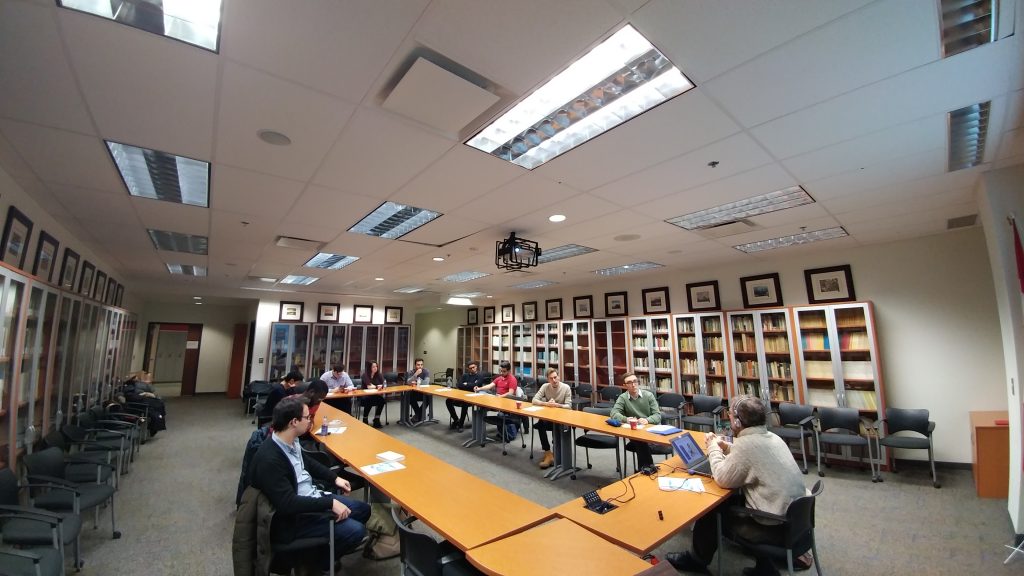The Geo-economics of Energy Resources
Contents
- 1 The Geo-economics of Energy Resources: How Natural Gas Opens Potentials for the European Union’s Cooperation with Central Asia
- 2 Outline of Seminar
- 2.1 Introduction
- 2.2 A Few Ideas
- 2.3 A Few Examples
- 2.4 Nestedness and Emergent Coherence
- 2.5 TCGP–White Stream
- 2.6 Summary and Conclusion
The Geo-economics of Energy Resources: How Natural Gas Opens Potentials for the European Union’s Cooperation with Central Asia
Public Talk invited by the International Relations Society, Concordia University, 19 January 2017.

Robert M. Cutler leads undergraduate seminar discussing Central Asian energy at Concordia University, 19 January 2017.
Robert M. Cutler leads undergraduate seminar discussing Central Asian energy at Concordia University, 19 January 2017.
Outline of Seminar
Introduction
A Few Ideas
What is a Complex System?
- A Complex System is a system having multiple interacting components, of which the overall behaviour cannot be inferred simply from the behaviour of the components.
- The canonical non-complex system is an automobile factory: from studying inputs and how they are trans-formed, one can predict what is produced. The canonical complex system is the biological cell.
- A complex system is characterized by three phrases of “emergent coherence”. Emergence is the first and coherence is the last, intermediated by “autopoiesis”, “self-creation” or “self-production”, which refers to the capacity of a complex system to establish autonomously and to pursue self-generated evolutionary goals.
What is a Hydrocarbon Energy Complex (HEC)?
- A Hydrocarbon Energy Complex (HEC) is a regional (typically transnational or international) geographical construct that is structurally unified by energy flows that are themselves typically institutionalized by oil and gas pipelines, not excluding translittoral (e.g., a Russia-Turkey pipeline under the Black Sea) or (in the case of liquefied natural gas, LNG) transoceanic vectors.
- The complex-scientific nature of an HEC emerges from the fact that development, production and pipeline transmission is a complex social system.
- Such a system contributes to configuring geopolitically the territories where the energy is produced, transited, and consumed. Its evolution is governed by the com-bined effects of internal dynamics of social and econo-mic growth, facing external geopolitical constraints.
Complex-scientific HEC Analysis: Three Components
- Emergent coherence analyzes and explains the extension of oil and gas pipeline networks from the Caspian Sea basin to Europe and China. A potential pipeline project is a complex system that interacts with its physical and human environ-ment. Beginning with its conception, it evolves through stages of development, altering its form through the principle of variation.
- Energy triangles implement the insights of network socio-logists that dynamics of triads differ qualitatively from any ag-gregation or iteration of bilateral/dyadic relations. The Baku-Tbilisi-Ceyhan oil pipeline was the first trilateral project implemented in the history of the world hydrocarbon industry.
- Nestedness signifies that every region is “nested” within various scales of analysis. Central Asia, for example, is nested within a broader yet well-defined ‘macro-region’ of (transborder) Greater Central Asia, itself located within a demographic, cultural, geographic and historical unity called Central Eurasia.
Complex-Scientific HEC Analysis: Implications
- The complex-scientific geo-economic HEC approach considers pipelines and their networks as complex systems executed by human agency that transform the human and physical economic, political, financial, and ideological environments in which they are embedded.
- Energy pipeline projects unify elements of adjacent geo-economic subregions in new ways, altering inherited balance-of-power geopolitics. They signify and embody cooperative ententes, sometimes verging on de facto political alliances, amongst different states. Oil and gas pipelines and their networks transform international regions and pro-mote interregional restructuring from the bottom up.
A Few Examples
Energy Triangles: Not Bilateral Relations
Energy Triangles and Three Nested Scales of Analysis
Nestedness: Greater Central Asia Intermediates Central Asia with Central Eurasia
Greater Central Asia; Greater Southwest Asia; Greater South Asia
Nestedness and Emergent Coherence
Nestedness and Emergent Coherence: Greater Central Asia intermediates Central Asia with Central Eurasia
Greater Central Asia
Greater Southwest Asia
Greater South Asia
Nestedness and Emergent Coherence: The Restructuring of Geo-economic Relations in Greater Southwest and Central (and Southern) Asia
TCGP–White Stream
2011 EU Concept of 2020 Infrastructure Priorities
TCGP in Imagined Caspian/Black Sea Context, mid-1990s (detail)
Azerbaijan and Gas Supplies to Southeast and East Central Europe
The TCGP in Southwest Asian Context

